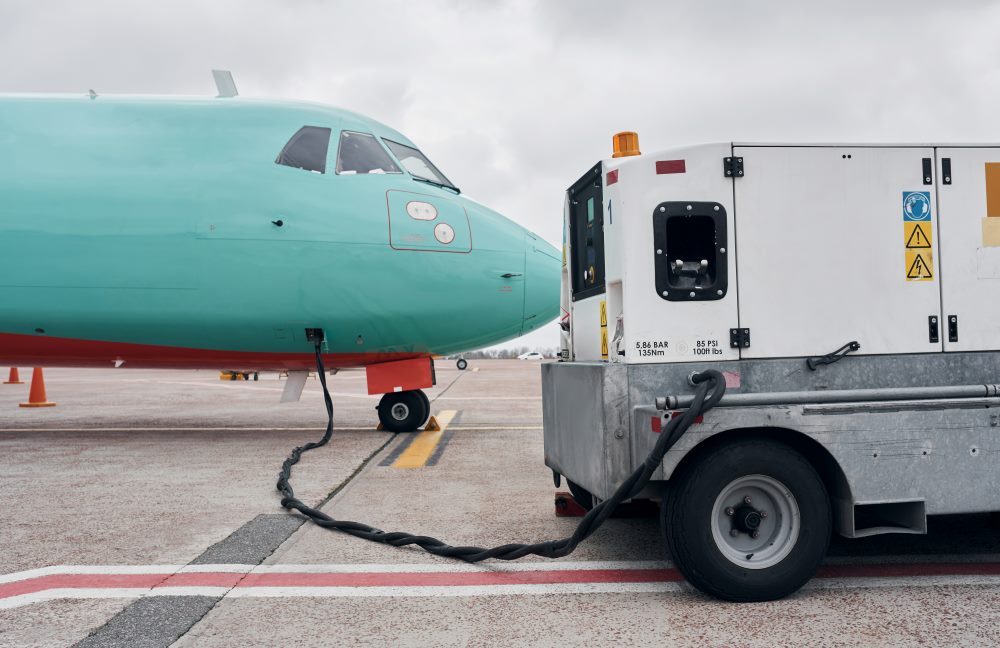Which Fuel is Used in Aeroplane/Helicopter/Jet & Types of Aircraft Fuels?

Have you ever wondered what is the fuel used in aeroplanes? From a small jet plane to a big airbus, aeroplanes need aviation fuel to operate.
Though there are several variants of aviation fuel available, most aeroplane companies prefer kerosene.
Want to know the reason?
Then, keep scrolling to know more about which fuel is used in an aeroplane and why.

Table of Contents

What is Aviation Fuel?
Aircraft fuel is a carefully formulated petroleum product that is designed uniquely to drive aeroplanes. That is designed to fulfil the higher standards of safety and performance required for flying aircraft engines. Its exceptional stability across temperature variations makes it appropriate for powering aeroplanes.
Which Fuel is Used for Rockets?
You can find multiple variants of aviation fuel worldwide. However, private jets, commercial aeroplanes, and general aviation aircraft usually depend on two types of aircraft fuel: Jet Fuel and AVGAS.
1. Jet fuel or Kerosene
Jet fuel is a refined kerosene-based fuel widely functional in aeroplanes with turbine engines, turboprops and jet engines.
You can find two variants of Jet Fuel, namely Jet A and Jet A1. There are basic manufacturing differences between these two types of fuel used in aircraft. These jet fuel variants can be used interchangeably to operate turbine-engines aeroplanes.
The main differences between Jet A and Jet A1 are-
Freezing Points- Usually, Jet A1 freezes at -47° while Jet-A freezing point is -40°C. The lower freezing point of Jet A1 makes it ideal for long international flights. The fuel variant is suitable for the ones flying over polar routes.
Additives- Jet A1 mostly contains additives that are static dissipaters. This helps to decrease the static charges which form due to jet fuel movement. Comparatively, Jet-A does not include static dissipater additives.
Usage- Jet A is prevalent in the US, while Jet A1 is universal or used in the rest of the world.
2. AVGAS
If you were wondering which fuel is used in jet aeroplanes, the answer is AVGAS. Aviation gasoline or AVGAS is a variant of aviation fuel that powers small piston-engine aeroplanes.
Usually, flight training jets, flying clubs and private pilots operate these aeroplanes.
AVGAS contains a significant amount of tetraethyl lead additive. The Tetraethyl lead prevents engine detonation or knocks, which can cause engine failures.
However, this fuel is toxic for human inhalation or absorption via the bloodstream. Therefore, it is advisable to use the fuel with caution.
There are two main types of AVGAS, which are AVGAS 100 and AVGAS 100LL. Here the 100 refers to the octane rating.
The basic differences among these types of fuel used in aeroplanes are-
Tetraethyl lead Additive- The AVGAS 100 has high lead content, while AVGAS 100LL includes low amounts of tetraethyl lead.
Colour- AVGAS 100LL sports an artificial blue dye, while AVGAS 100 sports a green dye.
Apart from understanding which type of fuel is used in aeroplanes and their differences, let’s learn its composition. This will help you understand the manufacturing process of this fuel.
3. SAF: New Sustainable Jet Fuels
Sustainable Aviation Fuel (SAF) is an eco-friendly alternative to traditional jet fuel that has been specially designed to reduce the carbon footprint of air travel significantly. It can be derived from various sustainable sources, such as biomass and waste materials, and through synthetic processes like Fischer-Tropsch synthesis.
The benefits of SAF are remarkable. It can reduce carbon emissions by up to 80% compared to conventional jet fuel. One of its biggest advantages is that it can be seamlessly blended with traditional jet fuel without requiring modifications.
However, there are challenges associated with SAF. Currently, the production costs of SAF are higher than those of conventional jet fuel. The availability of sustainable feedstocks in adequate quantities presents another significant challenge.
Here is a table listing different types of aircraft and the fuels they are run by:
SAF can be blended with these traditional fuels for the aircraft types listed above.
What is the Current Price of Aviation Fuel in India?
You should know that fuel prices change with the economic conditions and other related factors.
ATF Prices in Metros (Rupees/Kl) for Domestic Airlines from July 1, 2024 are as follows:
These are some of the essential details that answer your query on what fuel an aeroplane uses.
Having a detailed knowledge on this topic will help you understand how an airplane operates and the fuel requirement.
Now that you know about the fuel used in aeroplanes and variants, don’t forget to share it with your friends.
What are Octane Ratings in Aeroplane Fuel?
Octane ratings indicate how resistant a fuel is to knocking or pinging during combustion. In aviation, particularly for piston-engine aircraft, it is important to use avgas with high octane ratings, such as 100LL (low lead). This high rating is crucial for the engine's stable and optimal performance under different pressure and flight conditions.
This prevents the engine from knocking, which can result in some levels of damage and reduced efficiency.
What Colour is Aeroplane Fuel?
Aviation fuels are also marked with different colours to reduce cases of misfueling, which is very dangerous. For instance, avgas is dyed blue (100LL), green (100/130), red (80/87), or purple (115/145) depending on its grade. Jet-A and Jet-A1, a type of jet fuel, are usually clear or slightly coloured yellow or straw-like.
This colour coding enables the ground crew to quickly and clearly confirm the correct fuel type during refuelling, raising awareness and ensuring that aeroplanes are adequately supplied with the right grade as per their engines.
Types of Fuel Deposits
Fuel deposits on aircraft fuel systems and engines vary in formation and can hinder performance and reliability. These deposits include gum and varnish due to the oxidation and polymerisation of fuel components, mainly formed in the fuel tanks and lines.
Furthermore, due to incomplete combustion, carbon-related residues can adhere to the combustor walls and spark plugs. However, microbial activities within fuel tanks, especially in the presence of water, can produce sludge, which causes blockage of filters and corrosion of tanks. Frequent check-ups of the aircraft and fuel additives are strongly recommended to eradicate these challenges and enhance safe and efficient flight.
What Does Airplane Fuel Constitute?
Aeroplanes use jet fuels primarily derived from crude oil, known as liquid petroleum.
Organic materials found in shale, namely petroleum solids or kerogen,, are jet fuel sources. Manufacturers then use heat to convert these into shale oil.
This process has given these fuels the name of shale-derived jet fuels.
If you are wondering what is used as fuel in an aeroplane—gases or jet fuel, here’s a detailed explanation.
Why Do Aeroplanes Use Jet Fuel Instead of Gases?
It is obvious that aeroplanes cannot run on fumes. Hence, they use chemical energy stored in aviation fuels to power the engines.
Here are some reasons why jet fuel or kerosene is preferable -
Lower freezing point- Kerosene or Jet fuel has a lower freezing point, making it naturally protected against freezing temperatures. This is beneficial for flights passing over polar regions.
Low viscosity- Jet fuel has a lower viscosity during flight operation and, hence, is watery in nature. Due to its lower freezing point, it remains less viscous and watery during flights. This is a reason why jet fuel is used in aircraft.
High flash point- Flash point indicates the temperature when a flammable chemical ignites and turns into vapour. As jet fuel has a higher flash point, it offers higher octane to achieve greater power during flights.
Less expensive- kerosene is significantly cheaper than its counterparts, making it cost-effective.
Now that you know what the name of fuel used in aeroplanes is, let’s check how much fuel an aeroplane needs.
Why is Fuel Carried in Wings?
Fuel stored in aeroplane wings serves several functions. Placing the fuel in the wings helps distribute the weight of the fuel in an even manner, which provides stability and balance when flying. This configuration also reduces the wing's structural load since the weight is brought nearer to the middle of the aircraft.
In addition, using wing tanks is more efficient in terms of space, as the fuselage has to be occupied only by passengers and their baggage. The wings are intentionally made to encompass the load and structural requirement of safely and effectively bearing a large amount of fuel.
How Much Fuel Does an Aeroplane Consume?
To understand the fuel consumption, we need to consider flight size, distance covered and what type of fuel is used in an aeroplane.
For instance, an Airbus A321neo covers a distance of 1200 kilometres in two hours. Let’s say it flies at an average speed of 600 km per hour and has a sitting capacity of 192 people; it will consume around 4.18 litres of fuel per kilometre.
The flight will consume an average of 5,016 litres of fuel in the entire journey of 1200 kilometres.
Comparatively, a bigger flight like the Boeing 747 will approximately use 4 litres of fuel every second. This gives an estimate of 14,400 litres per hour and 240 litres per minute.
Since the flight uses a significant amount of fuel, it is essential to learn about current fuel prices in India.
How Can Planes Refuel Mid-Flight?
Aeroplanes can make mid-air refuelling through a process known as aerial refuelling or air-to-air refuelling. Normally, this is done by a second aircraft, known as the tanker aircraft, fitted with equipment such as a flying boom or a hose-and-drogue system. The receiving plane then extends a probe or receptacle to connect with the tanker’s refuelling system, allowing fuel to be transferred while both aircraft maintain formation.
Good coordination between the tanker and receiving planes is needed to accomplish this operation. This method is specifically important for military forces. Aviation fuel is critically important for the normal and safe use of planes. It is stored mostly in the wings to counterbalance the weight distribution and maintain stability. This fuel comprises high-octane types for piston engines and kerosene-based for jets.
















